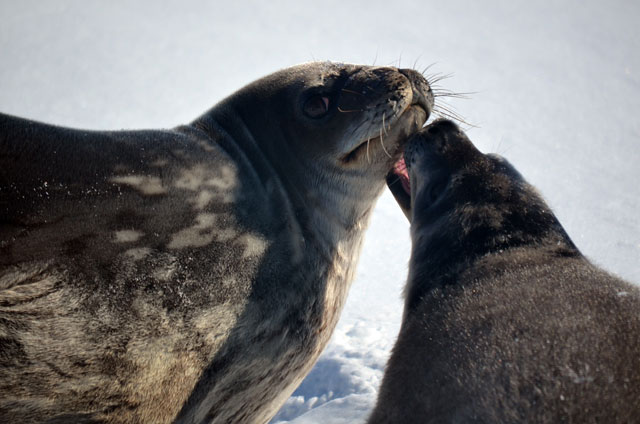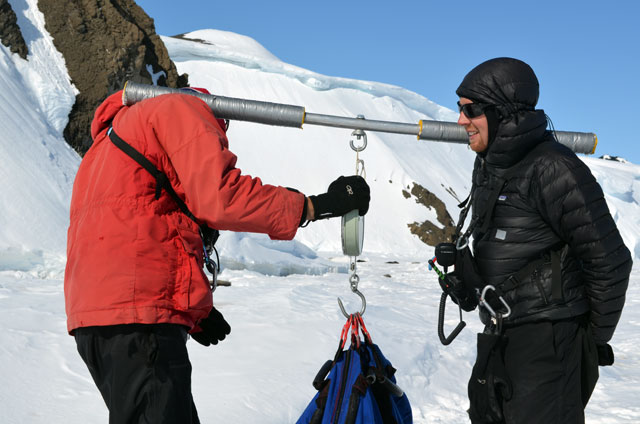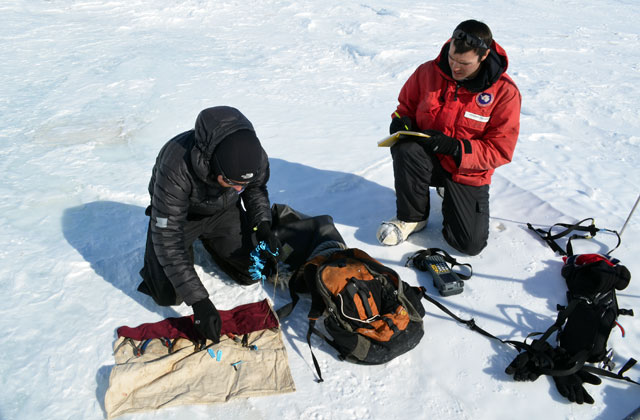Page 3/3 - Posted February 10, 2012
But even after more than 40 years of study, there is much about the Weddell seals that scientists don’t know. For example, last decade, when large icebergs choked off McMurdo Sound, allowing sea ice to build in both thickness and extent, few seals returned to Erebus Bay to breed. That was especially the case in 2004 when the sea ice edge was more than 90 kilometers from McMurdo Station. A few animals did successfully breed: the supermoms. But why? Are they so super that they could have navigated from open water in the Ross Sea, where researchers believe they overwinter, to Erebus Bay? Garrott is doubtful. Perhaps they never left, he suggested, remaining in McMurdo Sound where there are fewer predators and less competition when most of the seal population moves out to sea. “If you could make a living back here against the fast ice, because you were just better, more apt to be able do that, you wouldn’t have nearly the competition because most of the things that eats the fish that you eat, can’t live in solid ice like this,” he said. “The only way to understand how all of these variations are going to affect an ecosystem is that you have to have a study going on for a long time to capture good years, bad years and a bunch of average years, and you have to do it with the same methodology,” Garrott added. The program’s current five-year grant from the National Science Foundation’s Office of Polar Program In other words, the ecologists want to understand what makes one animal more successful than another. What makes a supermom? “Now that we’re focusing in on individual variations, we’re focusing on our sampling. We’re still going to do the mass dynamics study, but now we’re focusing on the same individuals every year,” Garrott said. Individual variation is apparent in behaviors right at the surface. Most Weddell seal moms seem unperturbed by Chambert and DeVoe as they handle the pups. But the pair cautiously approaches one long, sleek Weddell mom whose pup lies close by. As they get closer, she suddenly (for a seal) rears up and opens her mouth wide, showing sharp teeth. She spears her head in their direction, an obvious warning. “It’s really aggressive behavior for a Weddell seal,” said Chambert, giving the pup’s tag a quick glance and then checking his field notebook. Fortunately, it’s already been weighed. The overprotective mother is obviously a supermom, according to Chambert, with a long life history of breeding. She is 21 years old, not much younger than most of the field team. “We have some moms in the dataset that have produced upwards of 20 pups in their life,” Chambert noted. Eventually, the team hopes to link the life histories of individuals against their genetic makeup. They’ve already collected biological samples for collaborators at Harvard Medical School Weddell seals are capable of holding their breath of upwards to an hour. There are many possible medical applications if researchers can identify and isolate the specific genes that allow the animals to dive and function without fresh oxygen for so long. “If you can understand how Weddell seals can keep their brains functioning without oxygen, whatever those physiological processes are, you might have a way to administer a medicine to stroke victims immediately after a stroke to minimize brain damage from oxygen loss,” Garrott said. “That will be a big jump for us,” he said of the genetics study. “We’re thinking long term.” NSF-funded research in this story: Robert Garrott, Jay Rotella, and Donald Siniff, Montana State University, Award No. 0635739 |



For USAP Participants |
For The Public |
For Researchers and EducatorsContact UsU.S. National Science FoundationOffice of Polar Programs Geosciences Directorate 2415 Eisenhower Avenue, Suite W7100 Alexandria, VA 22314 Sign up for the NSF Office of Polar Programs newsletter and events. Feedback Form |





